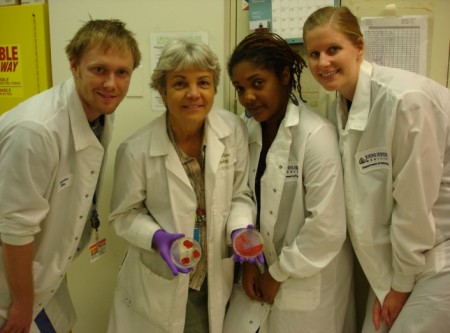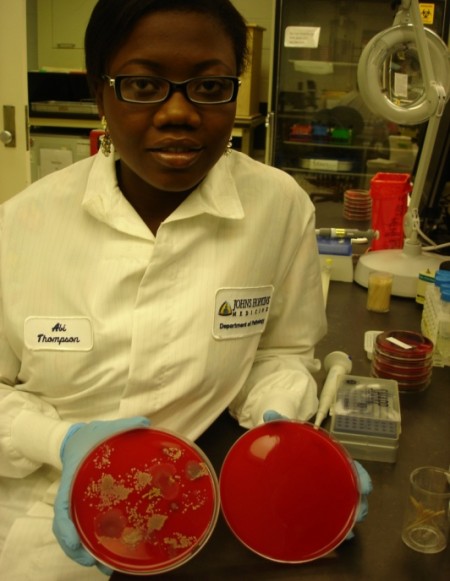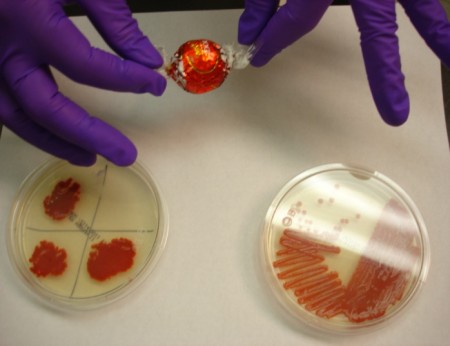From Lorraine Blagg, BS, MLS(ASCP)SBB, Education and Development Coordinator, Transfusion Medicine Division…….
The Young Scientists from the Paul L. Dunbar High School got to experience “Trauma and the Blood Bank” which utilized a presentation and role-playing to engage learners and promote collaboration. The presentation included information on trauma with potential treatment options and reviewed the roles of Hospital employees. The learners were divided into groups with each student having a role: trauma patient, doctor, nurse, blood bank technologist, and pharmacist. The trauma patient was given directions and a T-shirt to aid in acting out their trauma (motor vehicle accident, burn, and gunshot wound). The doctor and nurse collaborated to determine the appropriate treatment and choose from options like taking X-rays, administering pain medication, performing surgery, drawing blood, and giving blood products. The Blood Bank technologist was given a picture of ABO/Rh typing and selected blood products accordingly. Each choice had consequences that were provided by the instructor. Props were created like blood bags and candy medications to enhance the activity. The students identified how healthcare is a team effort, the importance of communication, and that each person plays an important role in patient care.
Both the students and I felt it was a very enriching and fun educational experience, and we look forward to continuing to work together in 2012.
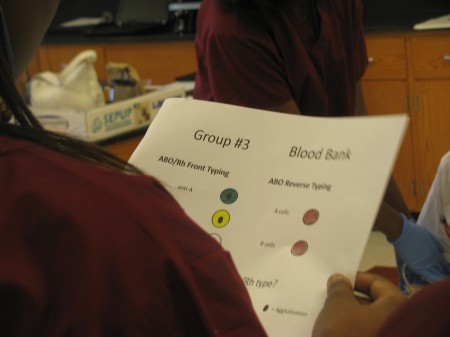
K’Arin interpreting ABO-Rh typings
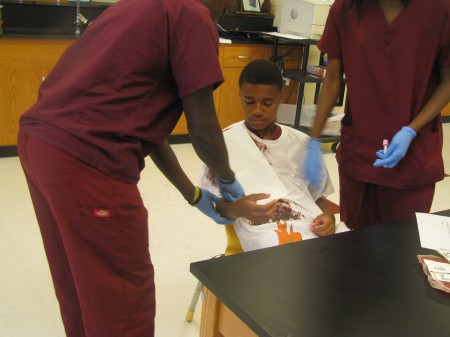
Melvin having skin applied to cover burn
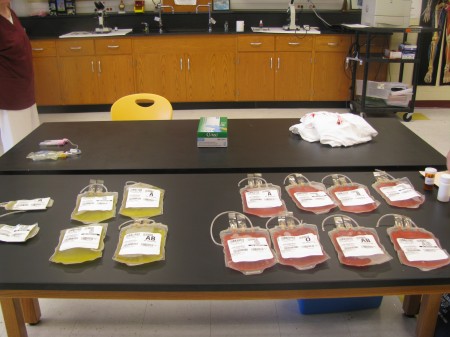
Our Blood Bank
From Annie Cho, MT(ASCP), Q/A Coordinator for the Division of Immunology…….
My presentation to the Dunbar students was about basic immunology and how immunology is involved in asthma. The presentation to the students included the following topics:
mmune system
- B cell and T cell function
- Immunoglobulin subclasses and their function
- Primary and secondary responses
- What causes asthma symptoms
- Management of asthma
In between immune system and asthma presentation, our Dunbar students got to measure their respiratory rate and pulse rate as an activity. Students also played word scramble after the presentation as a review process for what they learned from presentation.
It was the first time I presented to the students, so I was not sure how to interact with them. I was glad to spend time with these students. I had great time with them and am looking forward to doing this again next year.
From Fran Burroughs, SCT(ASCP), Supervisor, Cytology Technical Operations…….
In keeping with the interests of the students in the Dunbar summer science program, the Division of Cytopathology was contacted to provide information on the sexually transmitted diseases of Trichomonas vaginalis, Herpes simplex, and the STD most in the news – human papillomavirus (HPV), see below.
Armed with handouts and glass slides, the discussion centered around 1) disease types and the morphology of those diseases, and 2) the clinical manifestations and implications of patients with those diseases. After a straightforward presentation of the former, the class was most interested and knowledgeable about the latter. The discussion showed that some of the students had experience with the new HPV vaccine, recommended for young women between the ages of 11 and 26 – just the age range to capture optimal interest in this set of learners. The young men in the class, thinking they were immune from a series of three shots, were amazed to learn that there are clinical trials involving the vaccine and males, too! Eyes widened and interest piqued.
After all verbalized questions on each entity had been answered, the venue moved to the microscopes. Looking through a monocular scope, even though each had built in illumination, was an “eye closer” for me! It brought back my years in various science classes in high school and college, where we had to search for the light, be it sun, incandescent or fluorescent. Things change, but the principle is the same. The students were eager to see the protozoan Trich and the viral effect of both herpes and HPV. Notes were taken and drawings made as each peered into the microscopical world of the cell. The students were excited about the learning process and, hopefully, there will be some laboratorians in the making.
From Anna Füzéry, Ph.D., of the Core Lab…….
My name is Dr. Anna Füzéry and I am a first-year clinical chemistry fellow in the Department of Pathology. I have a longstanding interest in teaching, so when I was invited to participate in the Dunbar High School summer science program, I gladly accepted. In the past I have taught undergraduate and graduate students, advanced scientists, and even grade school children but I had a feeling that this experience would be different.
This year’s chemistry topic was cardiovascular disease and, together with Chris Hostetter, I prepared a 45-90 minute session consisting of a short lecture and several interactive group activities. I wasn’t sure how interesting this topic would be to high school students – after all, cardiovascular disease predominantly affects adults and the elderly. However, a very pleasant surprise was in store for me.
Upon arriving at Dunbar High, I was welcomed by 10 very friendly and enthusiastic students. From the very beginning, they seemed interested in the presentation and asked lots of questions about heart attacks and other aspects of cardiovascular disease. They also became very engrossed in the group activities, so much so that we almost had to go overtime to finish all of them. Overall, I was very impressed by this group of high-caliber students and enjoyed interacting with them very much. I hope that their enthusiasm for science along with their pursuit of excellence continues and I wish them much success in their studies.
And our final contribution to our post comes to us from Paula Mister, MT(ASCP), Educational and Development Coordinator of the Microbiology Lab…….
Contagion!
There’s nothing like a piece of gum or candy to start an epidemic……
My merry band of accomplices, technologists Abi Thompson, Brandon Ellis, Ava Roberts and Jamie Prestridge, and I provided a lesson in the spread of disease to the class of 15 students in the Dunbar Science program in August. The students and their teacher, Mrs. Mamie Green, donned gloves and were given a piece of wrapped gum. They unwrapped the gum, rubbed fingers of one hand on the gum, then “shook hands” with four other students around the room, putting their fingers on an agar plate after each “handshake”. One unwitting participant had an “infected” piece of gum, covered with a red pigment producing bacteria, Serratia marcesens. The next day, plates were examined to see how the “disease” spread around the room, and to determine who had the contaminated piece of gum. The “index case” turned out to be none other than Mrs. Green! Students thus had the opportunity to witness how easily an infection spreads from person to person by direct contact. Basic principles of epidemiology and infection control were discussed. The importance of hand washing was demonstrated by having a student put her hand on an agar plate before hand washing, then repeat the exercise after careful hand washing. The differences seen between the two plates the next day were another good visual demonstration of these principles.
Brandon Ellis, Paula Mister, Ava Roberts, and Jamie Prestridge show plates growing red pigmented bacteria Serratia marcesens
Ava Roberts with a piece of candy that can be used to start the spread of infection.
Abi Thompson with “before” (left) and “after” (right) hand wash plates
A close up of the “infective” organism and source of infection.
